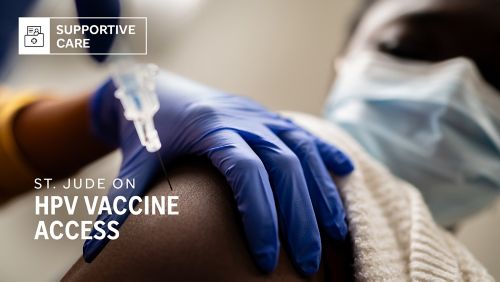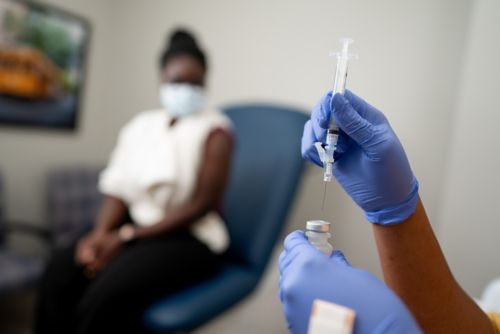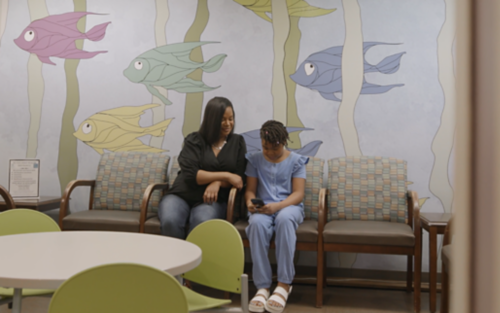St. Jude Family of Websites
Explore our cutting edge research, world-class patient care, career opportunities and more.
St. Jude Children's Research Hospital Home

- Fundraising
St. Jude Family of Websites
Explore our cutting edge research, world-class patient care, career opportunities and more.
St. Jude Children's Research Hospital Home

- Fundraising
Why do Black women have the highest cervical cancer mortality compared to all other groups in the United States?

The St. Jude HPV Cancer Prevention Program is working to address barriers to vaccination to provide protection against HPV related cancers.
Since the widespread introduction of cervical cancer screening in the United States, cervical cancer deaths have plummeted by 75%. However, not all women have benefited equally. According to the latest cancer statistics, cervical cancer is the third most common gynecological cancer in the United States. Effective population-based cervical cancer screening programs exist, but improvements in incidence and mortality are unequal among racial groups.
For example, Black women are 41% more likely to develop cervical cancer than white women and are 75% more likely to die from it. Further, Black women are more likely to be diagnosed at a later stage, which contributes to low five-year survival for a type of cancer for which almost every case can be prevented.
Almost all cases of cervical cancer are caused by human papillomavirus (HPV). A safe and effective vaccine for common types of cancer-causing HPV has been available in the U.S. since 2006. Almost all cases of cervical cancer are preventable through HPV vaccination and screening, including HPV and Pap tests. Regular screenings can also identify pre-cancers and prevent incident cases of cervical cancer, making it possible to take proactive steps to reduce risk.
The St. Jude HPV Cancer Prevention Program educates parents, clinicians, families and caregivers about the benefits of on-time vaccinations for children to prevent HPV cancers in adulthood. Our goal is to create a world free of HPV cancers, with the first focus of our program being cervical cancer. Looking ahead, we are extending our program efforts to include a series of seminars focused on different ethnic groups and health care gaps.
Addressing the issue of cervical cancer necessitates understanding why, if cervical cancer is almost entirely preventable, Black women are still developing and dying of cervical cancer at alarming rates.
There are multiple likely reasons for high rates of cervical cancer that originate in common factors contributing to overall health care gaps experienced by people who are Black in the U.S. Common barriers to cervical health include medical mistrust, lack of follow-up care and lack of information.

The HPV vaccine has been available in the U.S. since 2006 and can prevent almost all cases of cervical cancer.
Medical mistrust
There is a generational mistrust from Black women concerning health care practices based on the mistreatment of minorities at the hands of medical professionals.
While examples of medical mistreatment abound, from the work of J. Marion Sims to the Tuskegee Study, a particularly relevant example is that of Henrietta Lacks. Henrietta Lacks, a poor Black tobacco farmer and mother of five children, went to Johns Hopkins Hospital in the “colored ward” in 1951 with complaints of abnormal vaginal bleeding. Lacks began radium treatment for cervical cancer but passed away after eight months of treatment at the tender age of 31. Unknown to her family, samples of her cancer had been collected. In 1973, her cells were mass-produced for biomedical research and are now known worldwide as HeLa cells. Lacks’s cells contributed to understanding the natural history of and treatment for cervical cancer—but her consent was never acquired, and recognition of her contribution—academic and financial—would go unrealized for decades.
The mentality of medical mistrust generated by these and other historical mistreatments has been passed down over time. When avoiding regular gynecological care, Black women become more likely to be diagnosed with cervical cancer at an advanced stage, which decreases survival.
Lack of follow-up care
Timely follow-up care after receiving an abnormal cervical cancer screening is crucial in preventing cervical cancer and beginning treatment when warranted. Black women have the lowest follow-up rates after an abnormal screening. This low follow-up rate could result from limitations in health insurance, lack of regular access to health care providers, or insufficient communication from providers regarding test results, procedures, and next steps.
According to Human Rights Watch, these problems become greater as women age. Black women over the age of 70 are three times more likely to die from cervical cancer. Health screening guidelines often end at age 65, meaning there may be a missed opportunity to prevent cervical cancer in older women.
Lack of information
Knowledge is powerful, especially when acted upon. HPV vaccination is one such area where a lack of information results in missed opportunities. There are barriers to HPV vaccination, including inaccurate information about how people get HPV, a gap in health care providers giving patients the education necessary to understand the virus and a lack of health care providers offering and endorsing the vaccine. Lack of access to actionable health care information may also contribute to inequalities in HPV transmission and cervical cancer prevention. A health care provider’s vaccine recommendation to their patients carries the most weight in increasing vaccine uptake, making clear communication with patients of the utmost importance.
What can we do about it?
On-time HPV vaccination by age 13, cervical cancer screening as recommended and timely follow-up care and treatment are crucial in the prevention of cervical cancer. Speaking with a health care provider recommending the vaccine, in addition to personalized messages created for Black women, can address gaps in HPV-related information. Because there is a history of medical mistrust, there must be a heavy focus on patient engagement, increasing transparency and creating welcoming environments for Black women to learn about this disease and how they can start conversations to inform others. These practices will help improve access to information and awareness and potentially eliminate inequalities in cervical cancer.
The St. Jude HPV Cancer Prevention Program team is highly connected to national conversations about HPV vaccination as one of the vital steps to help fewer Black women develop and die of cervical cancer. With our strong network of allies and partners, our program is poised to take strides toward closing the health care disparity gaps and reducing the rate of cervical and other HPV-related cancers.









